Please use this identifier to cite or link to this item:
https://hdl.handle.net/11147/3104Full metadata record
| DC Field | Value | Language |
|---|---|---|
| dc.contributor.advisor | Dede, Mehmet İsmet Can | - |
| dc.contributor.author | Aytar, Erman Barış | - |
| dc.date.accessioned | 2014-07-22T13:50:52Z | - |
| dc.date.available | 2014-07-22T13:50:52Z | - |
| dc.date.issued | 2011 | - |
| dc.identifier.uri | http://hdl.handle.net/11147/3104 | - |
| dc.description | Thesis (Master)--Izmir Institute of Technology, Mechanical Engineering, Izmir, 2011 | en_US |
| dc.description | Includes bibliographical references (leaves: 104-107) | en_US |
| dc.description | Text in English; Abstract: Turkish and English | en_US |
| dc.description | xiii, 109 leaves | en_US |
| dc.description.abstract | Research on the underwater robotics has attracted the interest of many researchers over the years. The primary reasons are the need to perform underwater intervention tasks that are dangerous for a diver and the need to perform underwater survey tasks that last for longer periods of time. Unmanned underwater vehicles can be divided into two categories. Most of the systems, today, that require a certain level of precision and dexterity are built as Remotely Operated Vehicles (ROV). On the other hand, the systems that perform repetitive tasks are configured as Autonomous Underwater Vehicles (AUV). The objective of the thesis is to design a novel, cost-efficient, and fault-tolerant ROV that can hover and be used for shallow water investigation. In order to reduce the cost, the numbers of thrusters are minimized and internal actuators are used for steering the vehicle and stability in hovering mode. Also, the design is planned to be open for modification for further improvements that will enable the use of the vehicle for intervention tasks and studies. In this work, previously developed unmanned underwater vehicles are reviewed. Following this, the conceptual designs are created for the underwater vehicle and internal actuator designs are developed. Designed mechanisms are modeled in SolidWorks© and transferred to MATLAB© Simulink for hovering-mode control studies. Afterwards, to verify the simulation results, experiments are conducted with a seesaw mechanism by using LabVIEW© programming. Finally, results are given, discussed and future works are addressed. | en_US |
| dc.language.iso | en | en_US |
| dc.publisher | Izmir Institute of Technology | en_US |
| dc.rights | info:eu-repo/semantics/openAccess | en_US |
| dc.subject.lcsh | Remote submersibles--Design and construction | en |
| dc.subject.lcsh | Autonomous robots--Control systems | en |
| dc.title | Hovering-Mode Control of the Glider-Type Unmanned Underwater Vehicle | en_US |
| dc.type | Master Thesis | en_US |
| dc.institutionauthor | Aytar, Erman Barış | - |
| dc.department | Thesis (Master)--İzmir Institute of Technology, Mechanical Engineering | en_US |
| dc.relation.publicationcategory | Tez | en_US |
| dc.identifier.wosquality | N/A | - |
| dc.identifier.scopusquality | N/A | - |
| item.openairecristype | http://purl.org/coar/resource_type/c_18cf | - |
| item.languageiso639-1 | en | - |
| item.openairetype | Master Thesis | - |
| item.grantfulltext | open | - |
| item.fulltext | With Fulltext | - |
| item.cerifentitytype | Publications | - |
| Appears in Collections: | Master Degree / Yüksek Lisans Tezleri | |
Files in This Item:
| File | Description | Size | Format | |
|---|---|---|---|---|
| T000918.pdf | MasterThesis | 5.74 MB | Adobe PDF |  View/Open |
CORE Recommender
Page view(s)
322
checked on Mar 31, 2025
Download(s)
140
checked on Mar 31, 2025
Google ScholarTM
Check
Items in GCRIS Repository are protected by copyright, with all rights reserved, unless otherwise indicated.